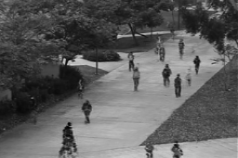Project Description
The project itself concentrates on the analysis of groups and smaller crowds. The aim of our work is to detect abnormal behavior by using person skeletons representing the pose of an individual. In the following, the two main topics are presented shortly.
Anomaly Detection
Anomaly detection is a very important topic in almost all fields of research. First, it is important to know what an anomaly actually is. Depending on the application, the exact definition can differ. Typical applications can range from detecting anomalies in circuit designs, to abnormal packages within a network, to salient behavior of a person or group of persons. In this project, we focus on detecting abnormal behavior recorded using surveillance cameras. We therefore apply generative approaches like Generative Adversarial Networks (GAN) and analyze time series using Long Short-Term Memories (LSTM), Recurrent Neural Networks (RNN), Hidden Markov Models (HMM) and others.
Human Pose Estimation
Extracting the pose of a person can be useful for different reasons like activity recognition and motion capturing. For example, within the medical field extracted poses can be used to analyze the movement of limbs of a person rehabilitating from an injury or to detect malfunctions in the human locomotive system. Due to lots of occlusions, the task of robust and reliable human pose estimation for multiple persons gets quite challenging. Furthermore, working with abstract poses allows us to preserve the privacy of a monitored person. Our work focuses on using human body poses for abnormal behavior detection / anomaly detection. This can range from certain activities like violence, but also tumbling people or people laying on the ground.


